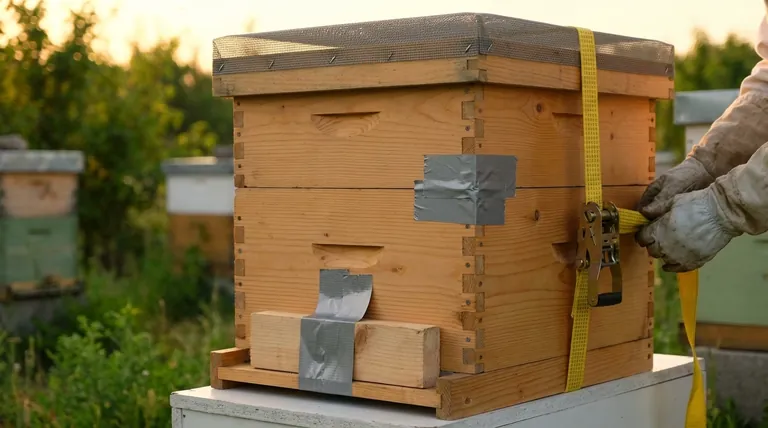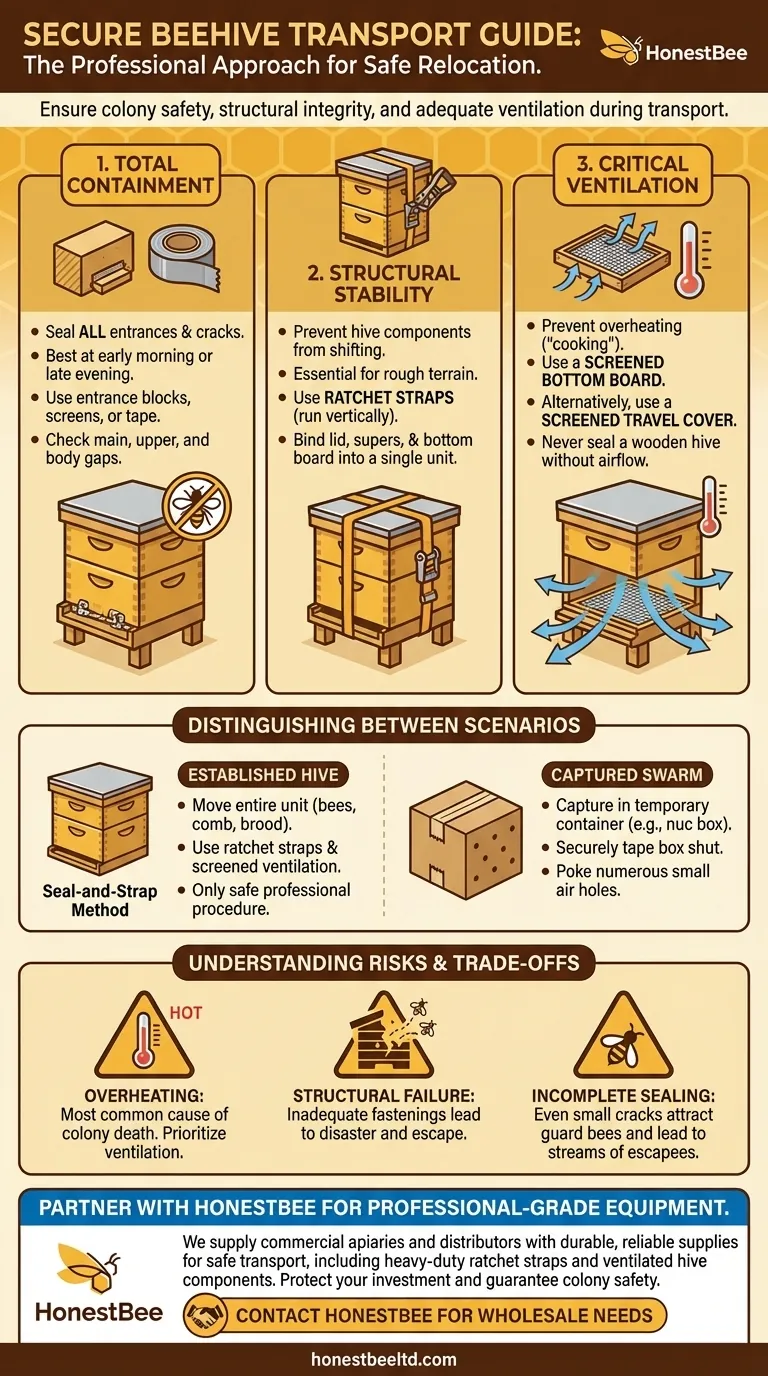To properly secure a beehive for transport, you must achieve two critical objectives: first, completely seal all entrances and cracks to contain the colony, and second, firmly fasten all hive components together to prevent any shifting. This is most effectively done using entrance blocks or screens to seal openings and ratchet straps to bind the hive body, bottom board, and lid into a single, stable unit.
The primary goal of securing a hive is not merely to prevent bees from escaping. It is a comprehensive strategy to protect the colony's structural integrity, ensure adequate ventilation, and minimize stress, guaranteeing a safe and successful relocation for the bees and the beekeeper.

The Core Principles of Hive Transport
Moving a colony of bees is a high-stakes operation that generates significant heat and stress within the hive. A successful move hinges on three principles: containment, stability, and ventilation.
Principle 1: Total Containment
The first step is to ensure the bees are confined within the hive. This is best done in the very early morning or late evening when all foraging bees have returned.
Check and seal every potential exit. This includes the main entrance, any upper entrances, and any cracks or gaps between boxes or in the hive body itself. Use entrance reducers, dedicated screened entrance blocks, or even hardware cloth stapled over the opening. For small gaps, strong duct tape can be effective.
Principle 2: Structural Stability
A full beehive is heavy and its parts can easily shift or separate during transport, especially over bumpy terrain. This can crush bees and damage comb.
The professional standard is to use ratchet straps. One or two straps should be run vertically or longitudinally around the entire hive, cinching the lid, hive bodies (supers), and bottom board together into a solid block. This prevents any component from sliding or tipping.
While tape may be sufficient for a very small, light nucleus hive (nuc), it is not a reliable method for full-sized hives.
Principle 3: Critical Ventilation
A sealed hive full of agitated bees will rapidly generate heat. Without proper airflow, the colony can quickly overheat and perish—a condition known as "cooking" the bees.
A screened bottom board is the ideal solution, as it provides excellent ventilation from below. If you don't have one, replace the inner cover and lid with a screened travel cover. This provides maximum airflow while keeping the bees contained. Never transport a fully sealed wooden hive without providing a significant source of ventilation.
Distinguishing Between Scenarios
The method for securing bees depends entirely on whether you are moving an established colony or a recently captured swarm.
Securing an Established Hive
For a standard Langstroth hive or nucleus hive, the seal-and-strap method is the only safe procedure. The goal is to move the entire established home—bees, comb, brood, and all—as one secure unit.
Securing a Captured Swarm
Moving a swarm involves capturing the cluster of bees in a temporary container, such as a cardboard nuc box or a dedicated swarm-catching box. In this case, security involves taping the box shut securely, but you must still poke numerous small air holes to provide ventilation for the journey.
Understanding the Risks and Trade-offs
Failing to properly secure a hive introduces significant risks that can lead to colony loss or public danger.
The Primary Risk: Overheating
This is the most common cause of colony death during a move. Using unvented lids and bottom boards on a sealed hive, especially during warm weather or a long trip, is extremely dangerous for the bees. Always prioritize ventilation.
The Danger of Structural Failure
Relying on gravity or inadequate fastenings like tape can lead to disaster. If a hive body shifts, it can create an exit for thousands of agitated bees. If it falls completely, you lose the colony and create a serious public safety hazard. Ratchet straps are not optional; they are essential equipment.
The Problem of Incomplete Sealing
Even a small, overlooked crack can become a major issue. A few guard bees will find the exit and release alarm pheromone, attracting many more to the opening. This can result in a steady stream of defensive bees escaping throughout the journey.
Making the Right Choice for Your Move
Your preparation should match the specific hive you are transporting.
- If your primary focus is moving a small nucleus hive (nuc): Sealing the entrance and using heavy-duty tape may suffice for a very short, smooth trip, but a strap is always better.
- If your primary focus is moving a full-sized, multi-box hive: Using ratchet straps and a screened bottom board or screened travel cover is the only safe and professional method.
- If your primary focus is transporting a captured swarm: Ensure the temporary box is securely taped shut but has ample air holes for ventilation.
Thorough preparation is the definitive factor in ensuring a safe, low-stress move for your bees and peace of mind for you.
Summary Table:
| Principle | Key Action | Equipment Needed |
|---|---|---|
| Containment | Seal all entrances and cracks. | Entrance blocks, screens, duct tape. |
| Stability | Firmly fasten all hive components. | Ratchet straps. |
| Ventilation | Provide airflow to prevent overheating. | Screened bottom board or travel cover. |
Ensure your next hive move is a complete success with professional-grade equipment from HONESTBEE.
We supply commercial apiaries and beekeeping equipment distributors with the durable, reliable supplies needed for safe transport, including heavy-duty ratchet straps and ventilated hive components. Protect your investment and guarantee the safety of your colonies.
Contact HONESTBEE today to discuss your wholesale needs and get the right equipment for the job.
Visual Guide

Related Products
- Professional Galvanized Hive Strap with Secure Locking Buckle for Beekeeping
- HONESTBEE Advanced Ergonomic Stainless Steel Hive Tool for Beekeeping
- Versatile Ratchet Hive Strap with S-Hooks for Secure Fastening
- Wholesales Dadant Size Wooden Bee Hives for Beekeeping
- Heavy Duty Ratchet Hive Strap
People Also Ask
- What is the best length for straps used around beehives? Why 12 Feet is the Industry Standard
- Can straps with hook ends be used for beehives? A Guide to Secure Hive Management
- What are the two styles of hive straps? Choose the Right Strap for Your Hive Security
- Why are hive straps important for beekeepers? Secure Your Hives Against Wind, Predators & Transport
- What are hive straps and why are they used? Secure Your Hives Against Wind, Predators, and Transport



















